University Finance Report: Management Accounting Techniques and Tools
VerifiedAdded on 2023/01/13
|20
|4629
|57
Report
AI Summary
This report on management accounting delves into various techniques, focusing on cost analysis and budgeting. It begins with an introduction to management accounting and its significance, followed by an in-depth exploration of cost calculation methods, including marginal and absorption costing. The report provides detailed income statements for both costing methods, comparing their impact on profit and loss. It also covers the application of different management accounting techniques such as financial planning, financial statement analysis, cost accounting, fund flow analysis, cash flow analysis, standard costing, decision-making accounting, management information systems, statistical techniques, management reporting, and ratio analysis. Furthermore, the report explains the use of planning tools, particularly budgets, for planning and control, outlining the advantages and disadvantages of different budgetary control types. Finally, it examines how organizations can use management accounting to respond to financial problems, analyzing adaptations in management accounting systems to achieve sustainable success.
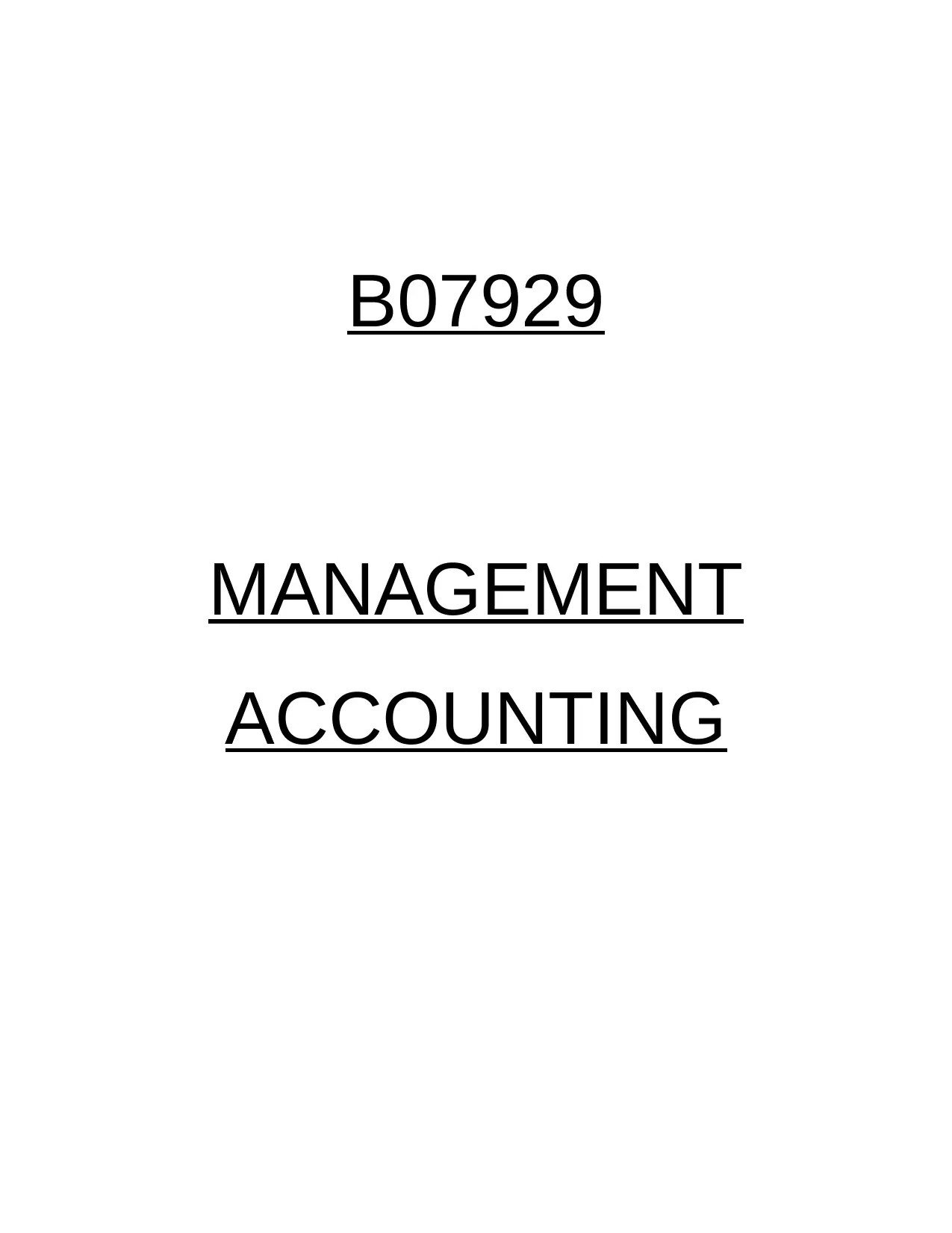
B07929
MANAGEMENT
ACCOUNTING
MANAGEMENT
ACCOUNTING
Paraphrase This Document
Need a fresh take? Get an instant paraphrase of this document with our AI Paraphraser
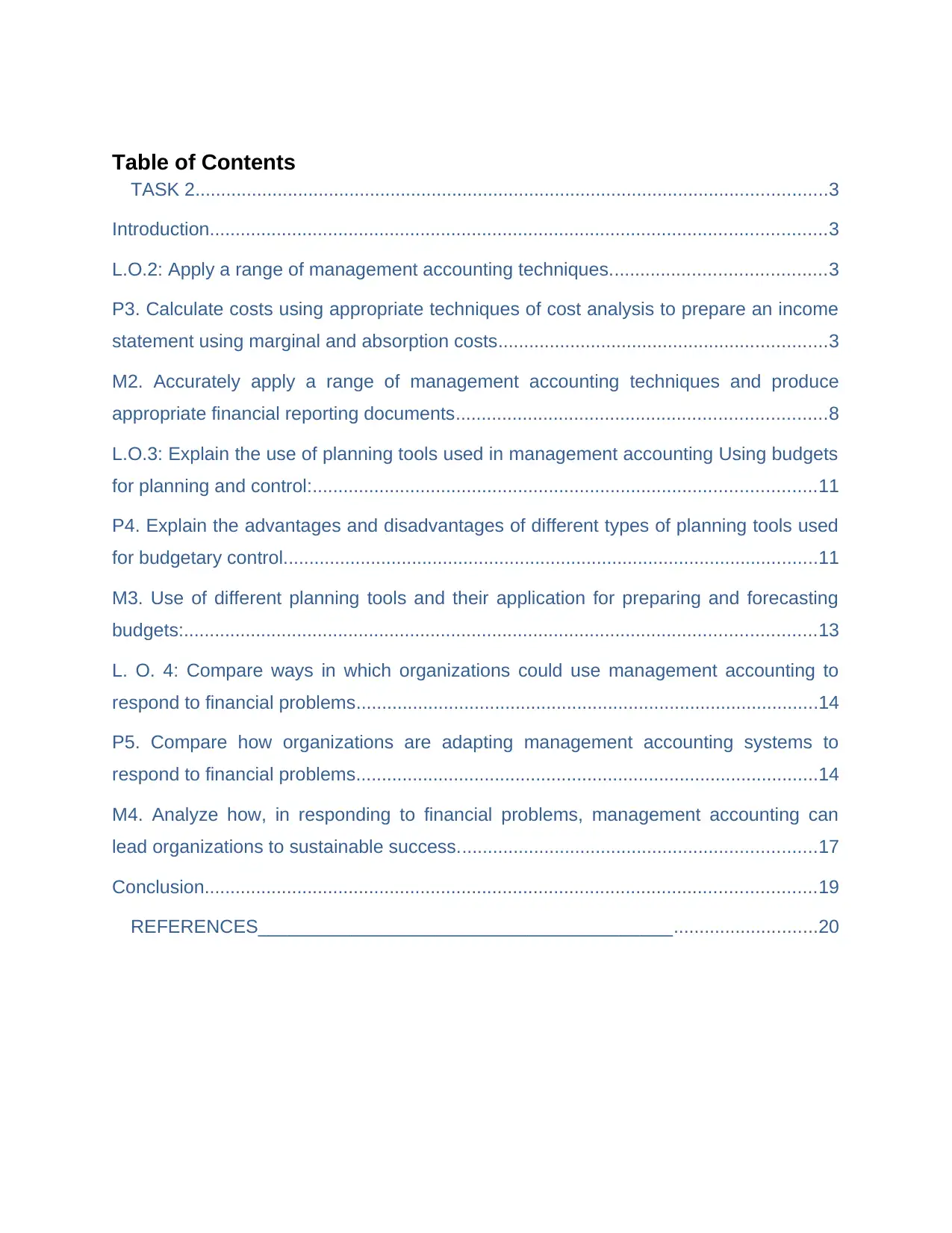
Table of Contents
TASK 2...........................................................................................................................3
Introduction........................................................................................................................3
L.O.2: Apply a range of management accounting techniques..........................................3
P3. Calculate costs using appropriate techniques of cost analysis to prepare an income
statement using marginal and absorption costs................................................................3
M2. Accurately apply a range of management accounting techniques and produce
appropriate financial reporting documents........................................................................8
L.O.3: Explain the use of planning tools used in management accounting Using budgets
for planning and control:..................................................................................................11
P4. Explain the advantages and disadvantages of different types of planning tools used
for budgetary control........................................................................................................11
M3. Use of different planning tools and their application for preparing and forecasting
budgets:...........................................................................................................................13
L. O. 4: Compare ways in which organizations could use management accounting to
respond to financial problems..........................................................................................14
P5. Compare how organizations are adapting management accounting systems to
respond to financial problems..........................................................................................14
M4. Analyze how, in responding to financial problems, management accounting can
lead organizations to sustainable success......................................................................17
Conclusion.......................................................................................................................19
REFERENCES________________________________________............................20
TASK 2...........................................................................................................................3
Introduction........................................................................................................................3
L.O.2: Apply a range of management accounting techniques..........................................3
P3. Calculate costs using appropriate techniques of cost analysis to prepare an income
statement using marginal and absorption costs................................................................3
M2. Accurately apply a range of management accounting techniques and produce
appropriate financial reporting documents........................................................................8
L.O.3: Explain the use of planning tools used in management accounting Using budgets
for planning and control:..................................................................................................11
P4. Explain the advantages and disadvantages of different types of planning tools used
for budgetary control........................................................................................................11
M3. Use of different planning tools and their application for preparing and forecasting
budgets:...........................................................................................................................13
L. O. 4: Compare ways in which organizations could use management accounting to
respond to financial problems..........................................................................................14
P5. Compare how organizations are adapting management accounting systems to
respond to financial problems..........................................................................................14
M4. Analyze how, in responding to financial problems, management accounting can
lead organizations to sustainable success......................................................................17
Conclusion.......................................................................................................................19
REFERENCES________________________________________............................20
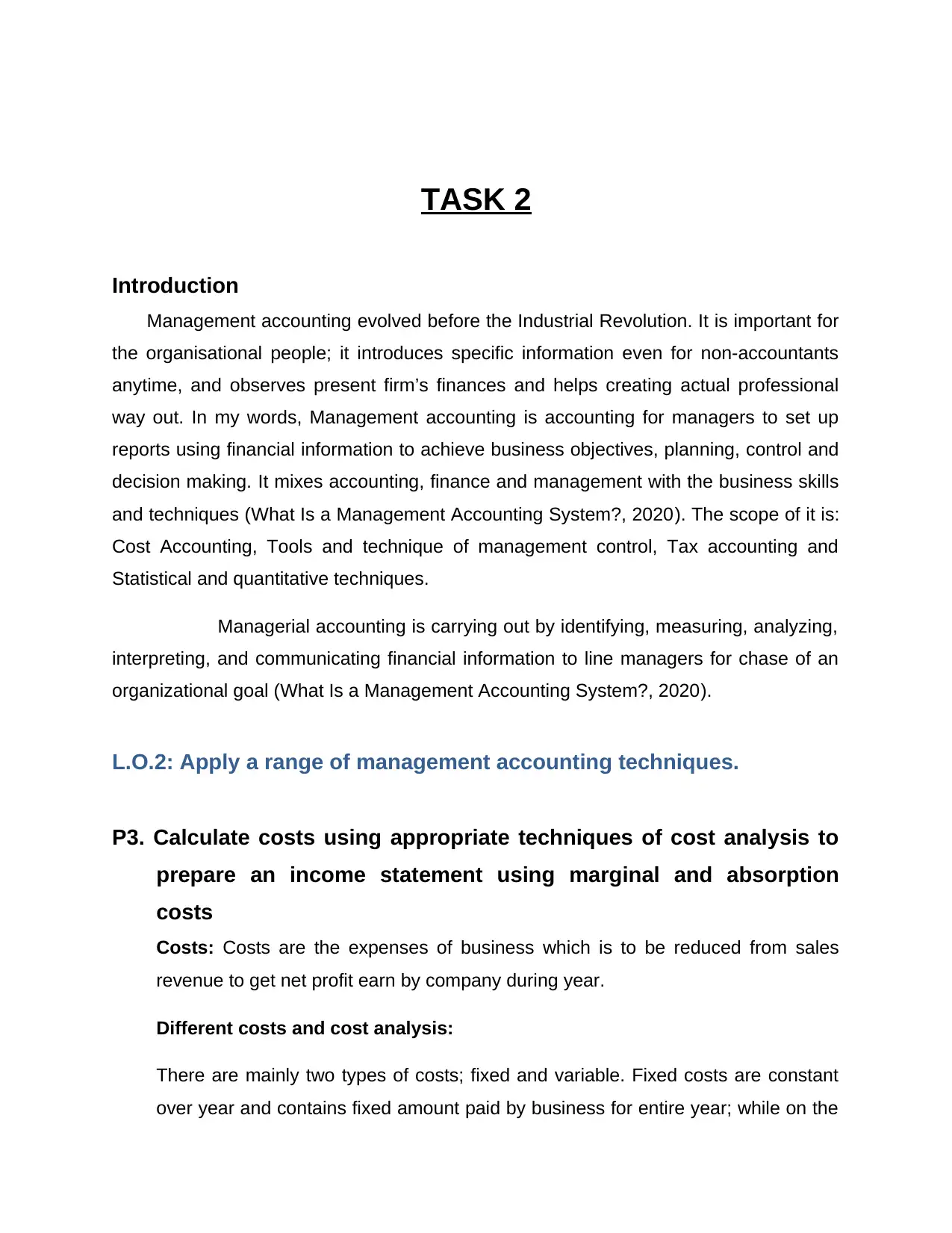
TASK 2
Introduction
Management accounting evolved before the Industrial Revolution. It is important for
the organisational people; it introduces specific information even for non-accountants
anytime, and observes present firm’s finances and helps creating actual professional
way out. In my words, Management accounting is accounting for managers to set up
reports using financial information to achieve business objectives, planning, control and
decision making. It mixes accounting, finance and management with the business skills
and techniques (What Is a Management Accounting System?, 2020). The scope of it is:
Cost Accounting, Tools and technique of management control, Tax accounting and
Statistical and quantitative techniques.
Managerial accounting is carrying out by identifying, measuring, analyzing,
interpreting, and communicating financial information to line managers for chase of an
organizational goal (What Is a Management Accounting System?, 2020).
L.O.2: Apply a range of management accounting techniques.
P3. Calculate costs using appropriate techniques of cost analysis to
prepare an income statement using marginal and absorption
costs
Costs: Costs are the expenses of business which is to be reduced from sales
revenue to get net profit earn by company during year.
Different costs and cost analysis:
There are mainly two types of costs; fixed and variable. Fixed costs are constant
over year and contains fixed amount paid by business for entire year; while on the
Introduction
Management accounting evolved before the Industrial Revolution. It is important for
the organisational people; it introduces specific information even for non-accountants
anytime, and observes present firm’s finances and helps creating actual professional
way out. In my words, Management accounting is accounting for managers to set up
reports using financial information to achieve business objectives, planning, control and
decision making. It mixes accounting, finance and management with the business skills
and techniques (What Is a Management Accounting System?, 2020). The scope of it is:
Cost Accounting, Tools and technique of management control, Tax accounting and
Statistical and quantitative techniques.
Managerial accounting is carrying out by identifying, measuring, analyzing,
interpreting, and communicating financial information to line managers for chase of an
organizational goal (What Is a Management Accounting System?, 2020).
L.O.2: Apply a range of management accounting techniques.
P3. Calculate costs using appropriate techniques of cost analysis to
prepare an income statement using marginal and absorption
costs
Costs: Costs are the expenses of business which is to be reduced from sales
revenue to get net profit earn by company during year.
Different costs and cost analysis:
There are mainly two types of costs; fixed and variable. Fixed costs are constant
over year and contains fixed amount paid by business for entire year; while on the
⊘ This is a preview!⊘
Do you want full access?
Subscribe today to unlock all pages.

Trusted by 1+ million students worldwide
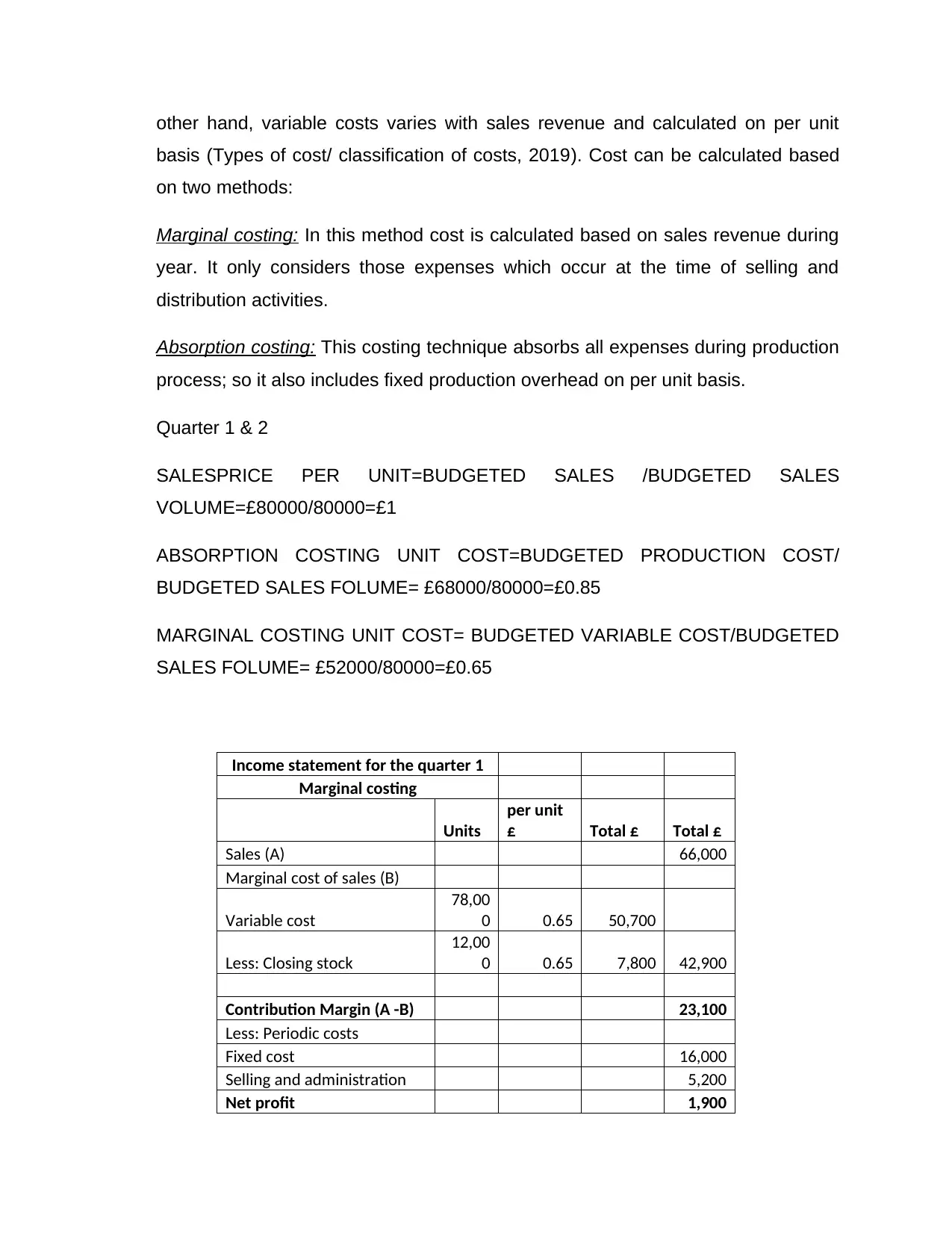
other hand, variable costs varies with sales revenue and calculated on per unit
basis (Types of cost/ classification of costs, 2019). Cost can be calculated based
on two methods:
Marginal costing: In this method cost is calculated based on sales revenue during
year. It only considers those expenses which occur at the time of selling and
distribution activities.
Absorption costing: This costing technique absorbs all expenses during production
process; so it also includes fixed production overhead on per unit basis.
Quarter 1 & 2
SALESPRICE PER UNIT=BUDGETED SALES /BUDGETED SALES
VOLUME=£80000/80000=£1
ABSORPTION COSTING UNIT COST=BUDGETED PRODUCTION COST/
BUDGETED SALES FOLUME= £68000/80000=£0.85
MARGINAL COSTING UNIT COST= BUDGETED VARIABLE COST/BUDGETED
SALES FOLUME= £52000/80000=£0.65
Income statement for the quarter 1
Marginal costing
Units
per unit
£ Total £ Total £
Sales (A) 66,000
Marginal cost of sales (B)
Variable cost
78,00
0 0.65 50,700
Less: Closing stock
12,00
0 0.65 7,800 42,900
Contribution Margin (A -B) 23,100
Less: Periodic costs
Fixed cost 16,000
Selling and administration 5,200
Net profit 1,900
basis (Types of cost/ classification of costs, 2019). Cost can be calculated based
on two methods:
Marginal costing: In this method cost is calculated based on sales revenue during
year. It only considers those expenses which occur at the time of selling and
distribution activities.
Absorption costing: This costing technique absorbs all expenses during production
process; so it also includes fixed production overhead on per unit basis.
Quarter 1 & 2
SALESPRICE PER UNIT=BUDGETED SALES /BUDGETED SALES
VOLUME=£80000/80000=£1
ABSORPTION COSTING UNIT COST=BUDGETED PRODUCTION COST/
BUDGETED SALES FOLUME= £68000/80000=£0.85
MARGINAL COSTING UNIT COST= BUDGETED VARIABLE COST/BUDGETED
SALES FOLUME= £52000/80000=£0.65
Income statement for the quarter 1
Marginal costing
Units
per unit
£ Total £ Total £
Sales (A) 66,000
Marginal cost of sales (B)
Variable cost
78,00
0 0.65 50,700
Less: Closing stock
12,00
0 0.65 7,800 42,900
Contribution Margin (A -B) 23,100
Less: Periodic costs
Fixed cost 16,000
Selling and administration 5,200
Net profit 1,900
Paraphrase This Document
Need a fresh take? Get an instant paraphrase of this document with our AI Paraphraser
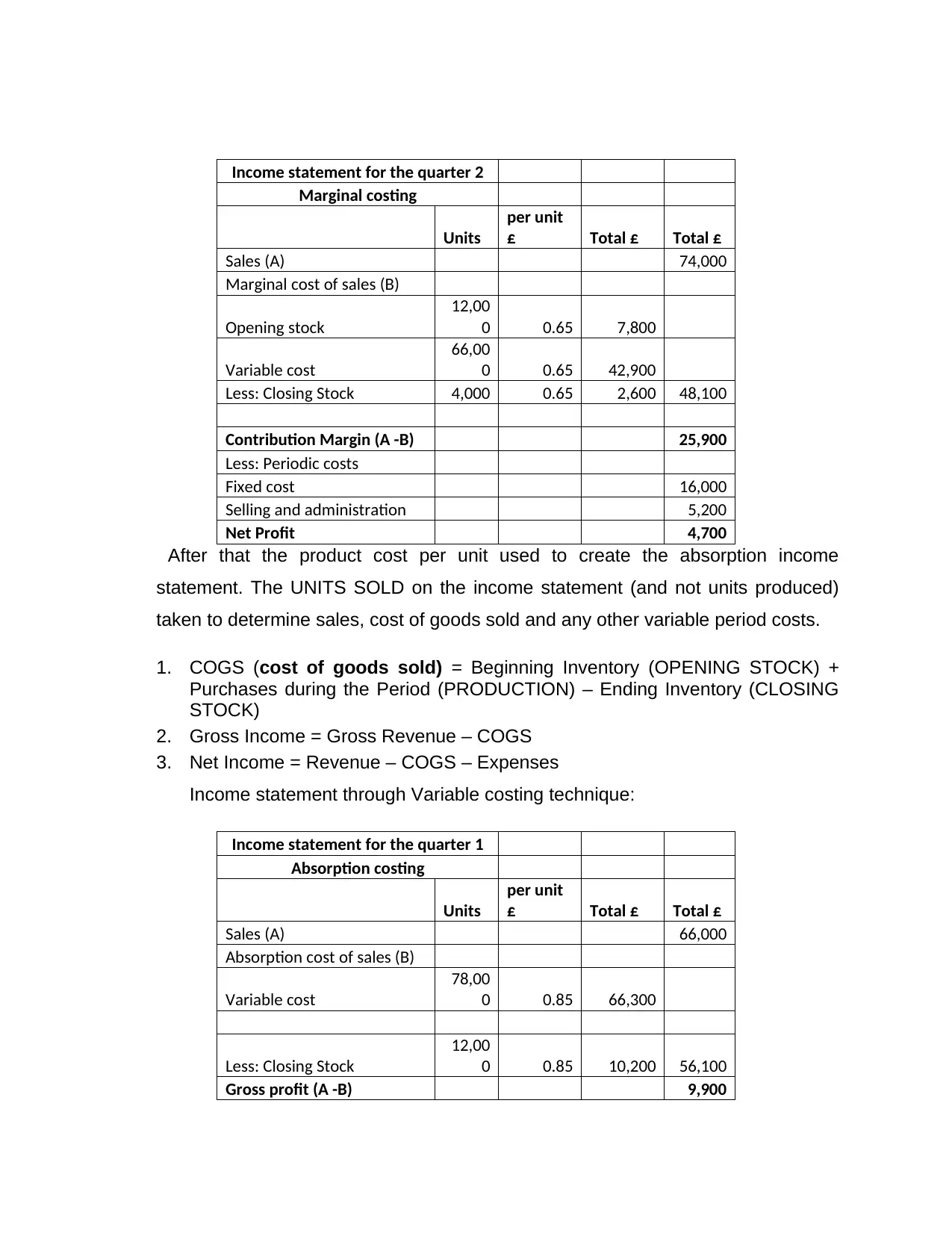
Income statement for the quarter 2
Marginal costing
Units
per unit
£ Total £ Total £
Sales (A) 74,000
Marginal cost of sales (B)
Opening stock
12,00
0 0.65 7,800
Variable cost
66,00
0 0.65 42,900
Less: Closing Stock 4,000 0.65 2,600 48,100
Contribution Margin (A -B) 25,900
Less: Periodic costs
Fixed cost 16,000
Selling and administration 5,200
Net Profit 4,700
After that the product cost per unit used to create the absorption income
statement. The UNITS SOLD on the income statement (and not units produced)
taken to determine sales, cost of goods sold and any other variable period costs.
1. COGS (cost of goods sold) = Beginning Inventory (OPENING STOCK) +
Purchases during the Period (PRODUCTION) – Ending Inventory (CLOSING
STOCK)
2. Gross Income = Gross Revenue – COGS
3. Net Income = Revenue – COGS – Expenses
Income statement through Variable costing technique:
Income statement for the quarter 1
Absorption costing
Units
per unit
£ Total £ Total £
Sales (A) 66,000
Absorption cost of sales (B)
Variable cost
78,00
0 0.85 66,300
Less: Closing Stock
12,00
0 0.85 10,200 56,100
Gross profit (A -B) 9,900
Marginal costing
Units
per unit
£ Total £ Total £
Sales (A) 74,000
Marginal cost of sales (B)
Opening stock
12,00
0 0.65 7,800
Variable cost
66,00
0 0.65 42,900
Less: Closing Stock 4,000 0.65 2,600 48,100
Contribution Margin (A -B) 25,900
Less: Periodic costs
Fixed cost 16,000
Selling and administration 5,200
Net Profit 4,700
After that the product cost per unit used to create the absorption income
statement. The UNITS SOLD on the income statement (and not units produced)
taken to determine sales, cost of goods sold and any other variable period costs.
1. COGS (cost of goods sold) = Beginning Inventory (OPENING STOCK) +
Purchases during the Period (PRODUCTION) – Ending Inventory (CLOSING
STOCK)
2. Gross Income = Gross Revenue – COGS
3. Net Income = Revenue – COGS – Expenses
Income statement through Variable costing technique:
Income statement for the quarter 1
Absorption costing
Units
per unit
£ Total £ Total £
Sales (A) 66,000
Absorption cost of sales (B)
Variable cost
78,00
0 0.85 66,300
Less: Closing Stock
12,00
0 0.85 10,200 56,100
Gross profit (A -B) 9,900
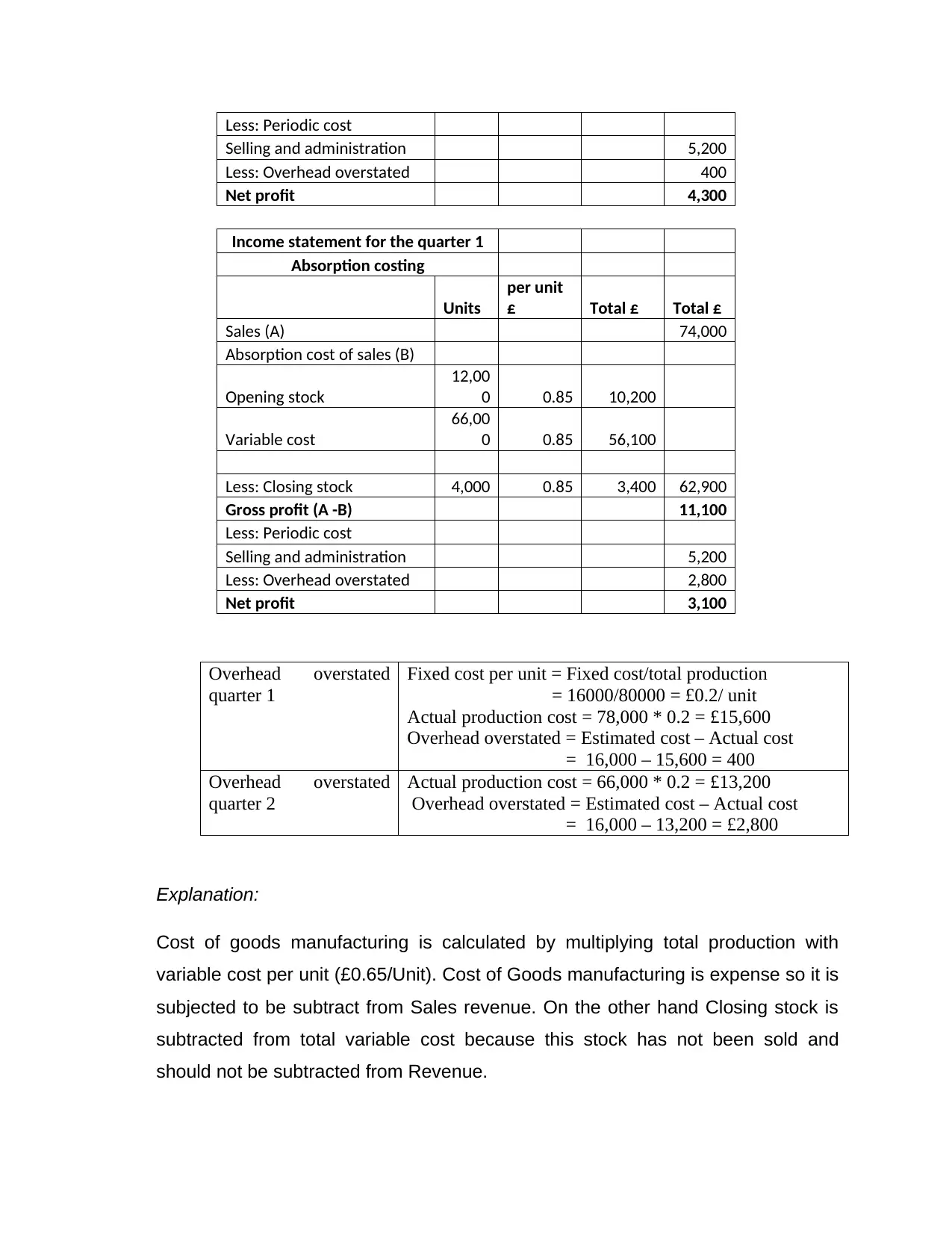
Less: Periodic cost
Selling and administration 5,200
Less: Overhead overstated 400
Net profit 4,300
Income statement for the quarter 1
Absorption costing
Units
per unit
£ Total £ Total £
Sales (A) 74,000
Absorption cost of sales (B)
Opening stock
12,00
0 0.85 10,200
Variable cost
66,00
0 0.85 56,100
Less: Closing stock 4,000 0.85 3,400 62,900
Gross profit (A -B) 11,100
Less: Periodic cost
Selling and administration 5,200
Less: Overhead overstated 2,800
Net profit 3,100
Overhead overstated
quarter 1
Fixed cost per unit = Fixed cost/total production
= 16000/80000 = £0.2/ unit
Actual production cost = 78,000 * 0.2 = £15,600
Overhead overstated = Estimated cost – Actual cost
= 16,000 – 15,600 = 400
Overhead overstated
quarter 2
Actual production cost = 66,000 * 0.2 = £13,200
Overhead overstated = Estimated cost – Actual cost
= 16,000 – 13,200 = £2,800
Explanation:
Cost of goods manufacturing is calculated by multiplying total production with
variable cost per unit (£0.65/Unit). Cost of Goods manufacturing is expense so it is
subjected to be subtract from Sales revenue. On the other hand Closing stock is
subtracted from total variable cost because this stock has not been sold and
should not be subtracted from Revenue.
Selling and administration 5,200
Less: Overhead overstated 400
Net profit 4,300
Income statement for the quarter 1
Absorption costing
Units
per unit
£ Total £ Total £
Sales (A) 74,000
Absorption cost of sales (B)
Opening stock
12,00
0 0.85 10,200
Variable cost
66,00
0 0.85 56,100
Less: Closing stock 4,000 0.85 3,400 62,900
Gross profit (A -B) 11,100
Less: Periodic cost
Selling and administration 5,200
Less: Overhead overstated 2,800
Net profit 3,100
Overhead overstated
quarter 1
Fixed cost per unit = Fixed cost/total production
= 16000/80000 = £0.2/ unit
Actual production cost = 78,000 * 0.2 = £15,600
Overhead overstated = Estimated cost – Actual cost
= 16,000 – 15,600 = 400
Overhead overstated
quarter 2
Actual production cost = 66,000 * 0.2 = £13,200
Overhead overstated = Estimated cost – Actual cost
= 16,000 – 13,200 = £2,800
Explanation:
Cost of goods manufacturing is calculated by multiplying total production with
variable cost per unit (£0.65/Unit). Cost of Goods manufacturing is expense so it is
subjected to be subtract from Sales revenue. On the other hand Closing stock is
subtracted from total variable cost because this stock has not been sold and
should not be subtracted from Revenue.
⊘ This is a preview!⊘
Do you want full access?
Subscribe today to unlock all pages.

Trusted by 1+ million students worldwide
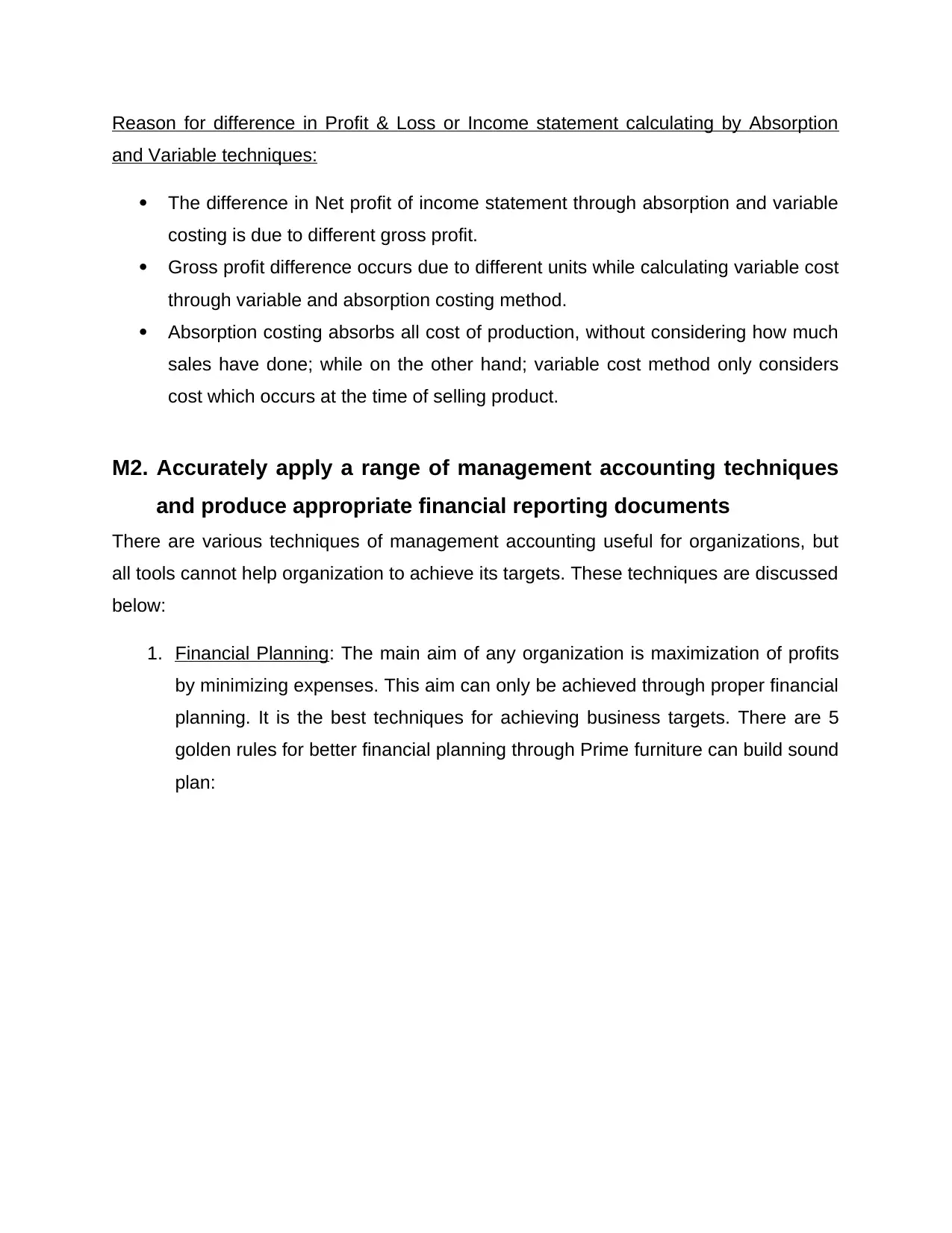
Reason for difference in Profit & Loss or Income statement calculating by Absorption
and Variable techniques:
The difference in Net profit of income statement through absorption and variable
costing is due to different gross profit.
Gross profit difference occurs due to different units while calculating variable cost
through variable and absorption costing method.
Absorption costing absorbs all cost of production, without considering how much
sales have done; while on the other hand; variable cost method only considers
cost which occurs at the time of selling product.
M2. Accurately apply a range of management accounting techniques
and produce appropriate financial reporting documents
There are various techniques of management accounting useful for organizations, but
all tools cannot help organization to achieve its targets. These techniques are discussed
below:
1. Financial Planning: The main aim of any organization is maximization of profits
by minimizing expenses. This aim can only be achieved through proper financial
planning. It is the best techniques for achieving business targets. There are 5
golden rules for better financial planning through Prime furniture can build sound
plan:
and Variable techniques:
The difference in Net profit of income statement through absorption and variable
costing is due to different gross profit.
Gross profit difference occurs due to different units while calculating variable cost
through variable and absorption costing method.
Absorption costing absorbs all cost of production, without considering how much
sales have done; while on the other hand; variable cost method only considers
cost which occurs at the time of selling product.
M2. Accurately apply a range of management accounting techniques
and produce appropriate financial reporting documents
There are various techniques of management accounting useful for organizations, but
all tools cannot help organization to achieve its targets. These techniques are discussed
below:
1. Financial Planning: The main aim of any organization is maximization of profits
by minimizing expenses. This aim can only be achieved through proper financial
planning. It is the best techniques for achieving business targets. There are 5
golden rules for better financial planning through Prime furniture can build sound
plan:
Paraphrase This Document
Need a fresh take? Get an instant paraphrase of this document with our AI Paraphraser
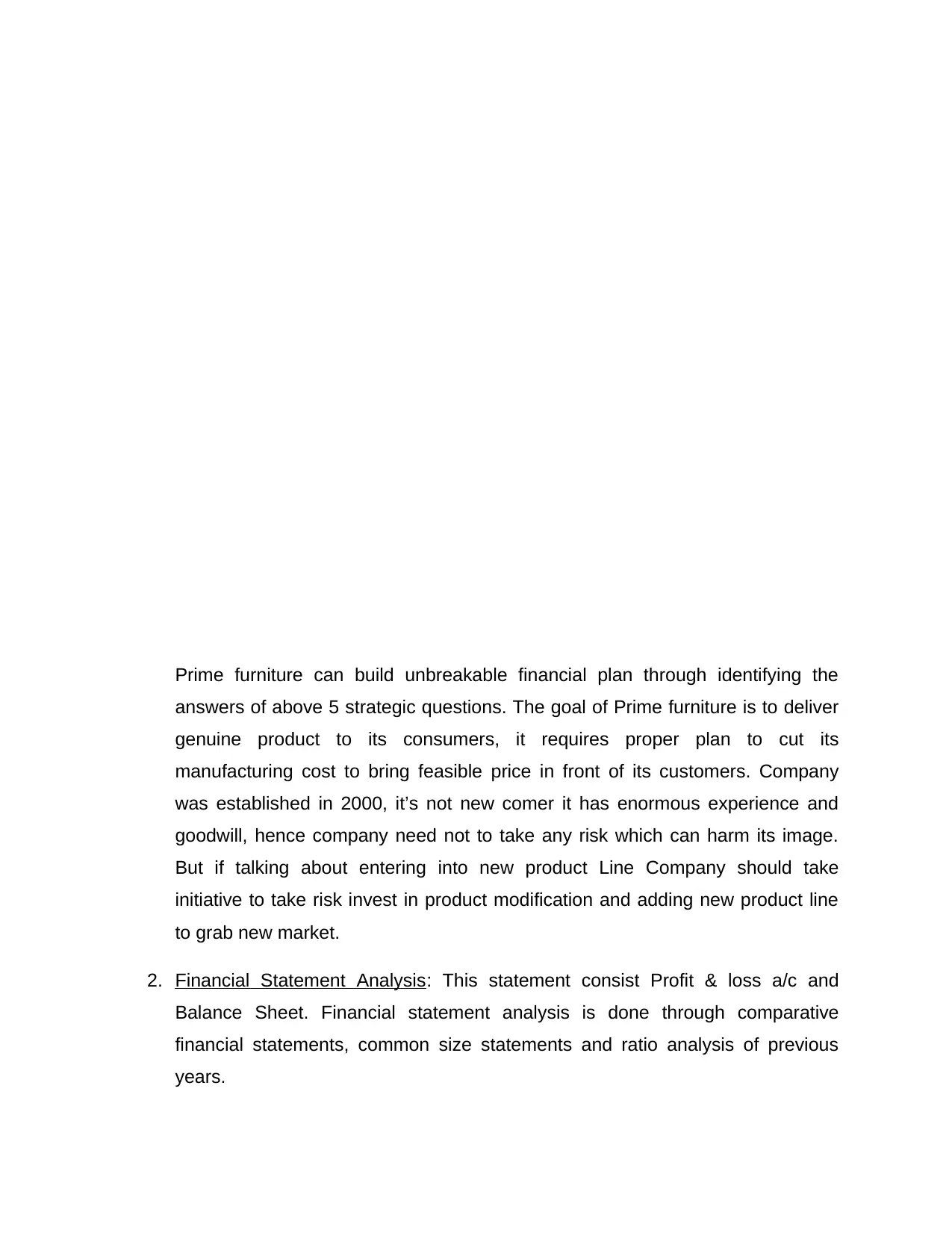
Prime furniture can build unbreakable financial plan through identifying the
answers of above 5 strategic questions. The goal of Prime furniture is to deliver
genuine product to its consumers, it requires proper plan to cut its
manufacturing cost to bring feasible price in front of its customers. Company
was established in 2000, it’s not new comer it has enormous experience and
goodwill, hence company need not to take any risk which can harm its image.
But if talking about entering into new product Line Company should take
initiative to take risk invest in product modification and adding new product line
to grab new market.
2. Financial Statement Analysis: This statement consist Profit & loss a/c and
Balance Sheet. Financial statement analysis is done through comparative
financial statements, common size statements and ratio analysis of previous
years.
answers of above 5 strategic questions. The goal of Prime furniture is to deliver
genuine product to its consumers, it requires proper plan to cut its
manufacturing cost to bring feasible price in front of its customers. Company
was established in 2000, it’s not new comer it has enormous experience and
goodwill, hence company need not to take any risk which can harm its image.
But if talking about entering into new product Line Company should take
initiative to take risk invest in product modification and adding new product line
to grab new market.
2. Financial Statement Analysis: This statement consist Profit & loss a/c and
Balance Sheet. Financial statement analysis is done through comparative
financial statements, common size statements and ratio analysis of previous
years.
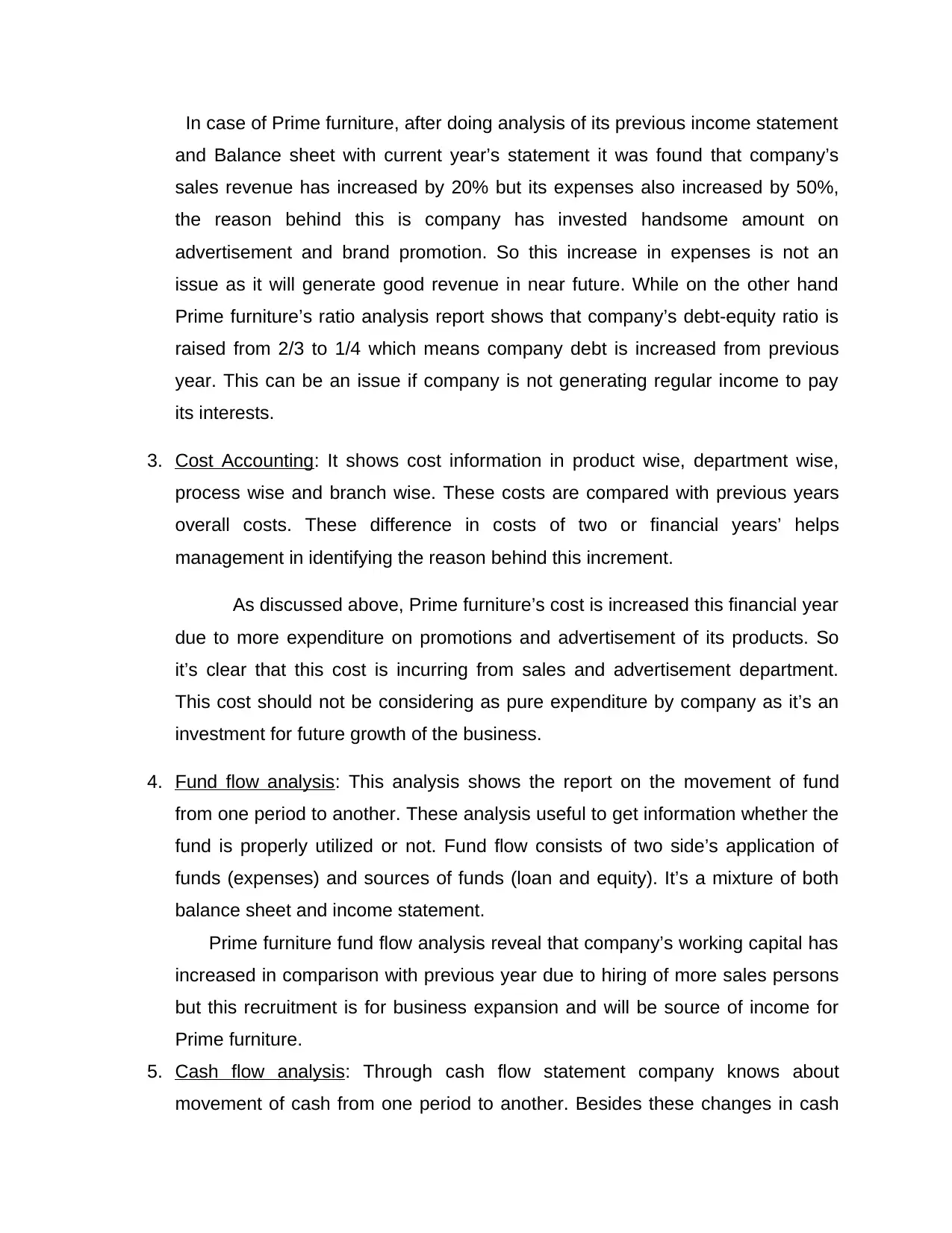
In case of Prime furniture, after doing analysis of its previous income statement
and Balance sheet with current year’s statement it was found that company’s
sales revenue has increased by 20% but its expenses also increased by 50%,
the reason behind this is company has invested handsome amount on
advertisement and brand promotion. So this increase in expenses is not an
issue as it will generate good revenue in near future. While on the other hand
Prime furniture’s ratio analysis report shows that company’s debt-equity ratio is
raised from 2/3 to 1/4 which means company debt is increased from previous
year. This can be an issue if company is not generating regular income to pay
its interests.
3. Cost Accounting: It shows cost information in product wise, department wise,
process wise and branch wise. These costs are compared with previous years
overall costs. These difference in costs of two or financial years’ helps
management in identifying the reason behind this increment.
As discussed above, Prime furniture’s cost is increased this financial year
due to more expenditure on promotions and advertisement of its products. So
it’s clear that this cost is incurring from sales and advertisement department.
This cost should not be considering as pure expenditure by company as it’s an
investment for future growth of the business.
4. Fund flow analysis: This analysis shows the report on the movement of fund
from one period to another. These analysis useful to get information whether the
fund is properly utilized or not. Fund flow consists of two side’s application of
funds (expenses) and sources of funds (loan and equity). It’s a mixture of both
balance sheet and income statement.
Prime furniture fund flow analysis reveal that company’s working capital has
increased in comparison with previous year due to hiring of more sales persons
but this recruitment is for business expansion and will be source of income for
Prime furniture.
5. Cash flow analysis: Through cash flow statement company knows about
movement of cash from one period to another. Besides these changes in cash
and Balance sheet with current year’s statement it was found that company’s
sales revenue has increased by 20% but its expenses also increased by 50%,
the reason behind this is company has invested handsome amount on
advertisement and brand promotion. So this increase in expenses is not an
issue as it will generate good revenue in near future. While on the other hand
Prime furniture’s ratio analysis report shows that company’s debt-equity ratio is
raised from 2/3 to 1/4 which means company debt is increased from previous
year. This can be an issue if company is not generating regular income to pay
its interests.
3. Cost Accounting: It shows cost information in product wise, department wise,
process wise and branch wise. These costs are compared with previous years
overall costs. These difference in costs of two or financial years’ helps
management in identifying the reason behind this increment.
As discussed above, Prime furniture’s cost is increased this financial year
due to more expenditure on promotions and advertisement of its products. So
it’s clear that this cost is incurring from sales and advertisement department.
This cost should not be considering as pure expenditure by company as it’s an
investment for future growth of the business.
4. Fund flow analysis: This analysis shows the report on the movement of fund
from one period to another. These analysis useful to get information whether the
fund is properly utilized or not. Fund flow consists of two side’s application of
funds (expenses) and sources of funds (loan and equity). It’s a mixture of both
balance sheet and income statement.
Prime furniture fund flow analysis reveal that company’s working capital has
increased in comparison with previous year due to hiring of more sales persons
but this recruitment is for business expansion and will be source of income for
Prime furniture.
5. Cash flow analysis: Through cash flow statement company knows about
movement of cash from one period to another. Besides these changes in cash
⊘ This is a preview!⊘
Do you want full access?
Subscribe today to unlock all pages.

Trusted by 1+ million students worldwide
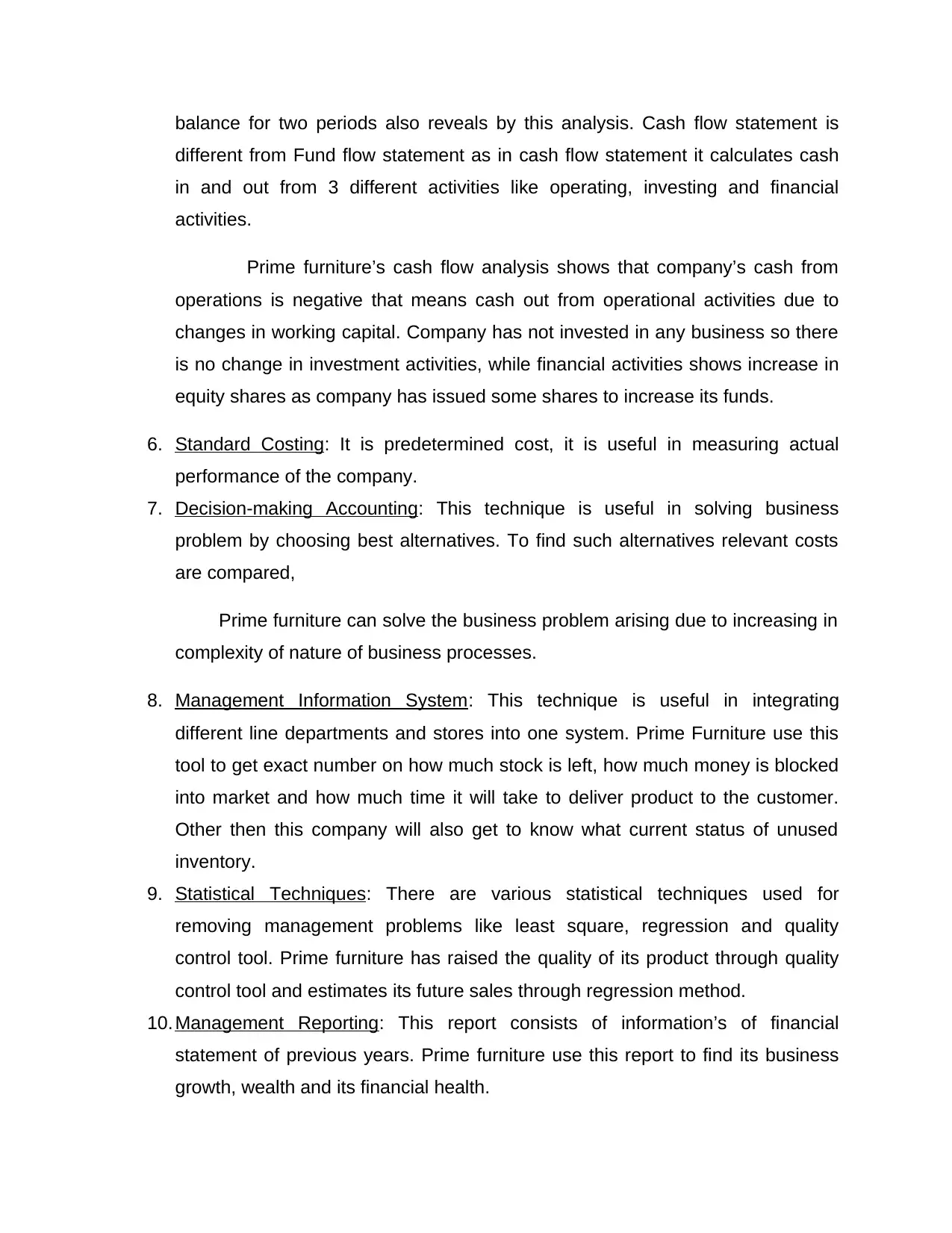
balance for two periods also reveals by this analysis. Cash flow statement is
different from Fund flow statement as in cash flow statement it calculates cash
in and out from 3 different activities like operating, investing and financial
activities.
Prime furniture’s cash flow analysis shows that company’s cash from
operations is negative that means cash out from operational activities due to
changes in working capital. Company has not invested in any business so there
is no change in investment activities, while financial activities shows increase in
equity shares as company has issued some shares to increase its funds.
6. Standard Costing: It is predetermined cost, it is useful in measuring actual
performance of the company.
7. Decision-making Accounting: This technique is useful in solving business
problem by choosing best alternatives. To find such alternatives relevant costs
are compared,
Prime furniture can solve the business problem arising due to increasing in
complexity of nature of business processes.
8. Management Information System: This technique is useful in integrating
different line departments and stores into one system. Prime Furniture use this
tool to get exact number on how much stock is left, how much money is blocked
into market and how much time it will take to deliver product to the customer.
Other then this company will also get to know what current status of unused
inventory.
9. Statistical Techniques: There are various statistical techniques used for
removing management problems like least square, regression and quality
control tool. Prime furniture has raised the quality of its product through quality
control tool and estimates its future sales through regression method.
10. Management Reporting: This report consists of information’s of financial
statement of previous years. Prime furniture use this report to find its business
growth, wealth and its financial health.
different from Fund flow statement as in cash flow statement it calculates cash
in and out from 3 different activities like operating, investing and financial
activities.
Prime furniture’s cash flow analysis shows that company’s cash from
operations is negative that means cash out from operational activities due to
changes in working capital. Company has not invested in any business so there
is no change in investment activities, while financial activities shows increase in
equity shares as company has issued some shares to increase its funds.
6. Standard Costing: It is predetermined cost, it is useful in measuring actual
performance of the company.
7. Decision-making Accounting: This technique is useful in solving business
problem by choosing best alternatives. To find such alternatives relevant costs
are compared,
Prime furniture can solve the business problem arising due to increasing in
complexity of nature of business processes.
8. Management Information System: This technique is useful in integrating
different line departments and stores into one system. Prime Furniture use this
tool to get exact number on how much stock is left, how much money is blocked
into market and how much time it will take to deliver product to the customer.
Other then this company will also get to know what current status of unused
inventory.
9. Statistical Techniques: There are various statistical techniques used for
removing management problems like least square, regression and quality
control tool. Prime furniture has raised the quality of its product through quality
control tool and estimates its future sales through regression method.
10. Management Reporting: This report consists of information’s of financial
statement of previous years. Prime furniture use this report to find its business
growth, wealth and its financial health.
Paraphrase This Document
Need a fresh take? Get an instant paraphrase of this document with our AI Paraphraser
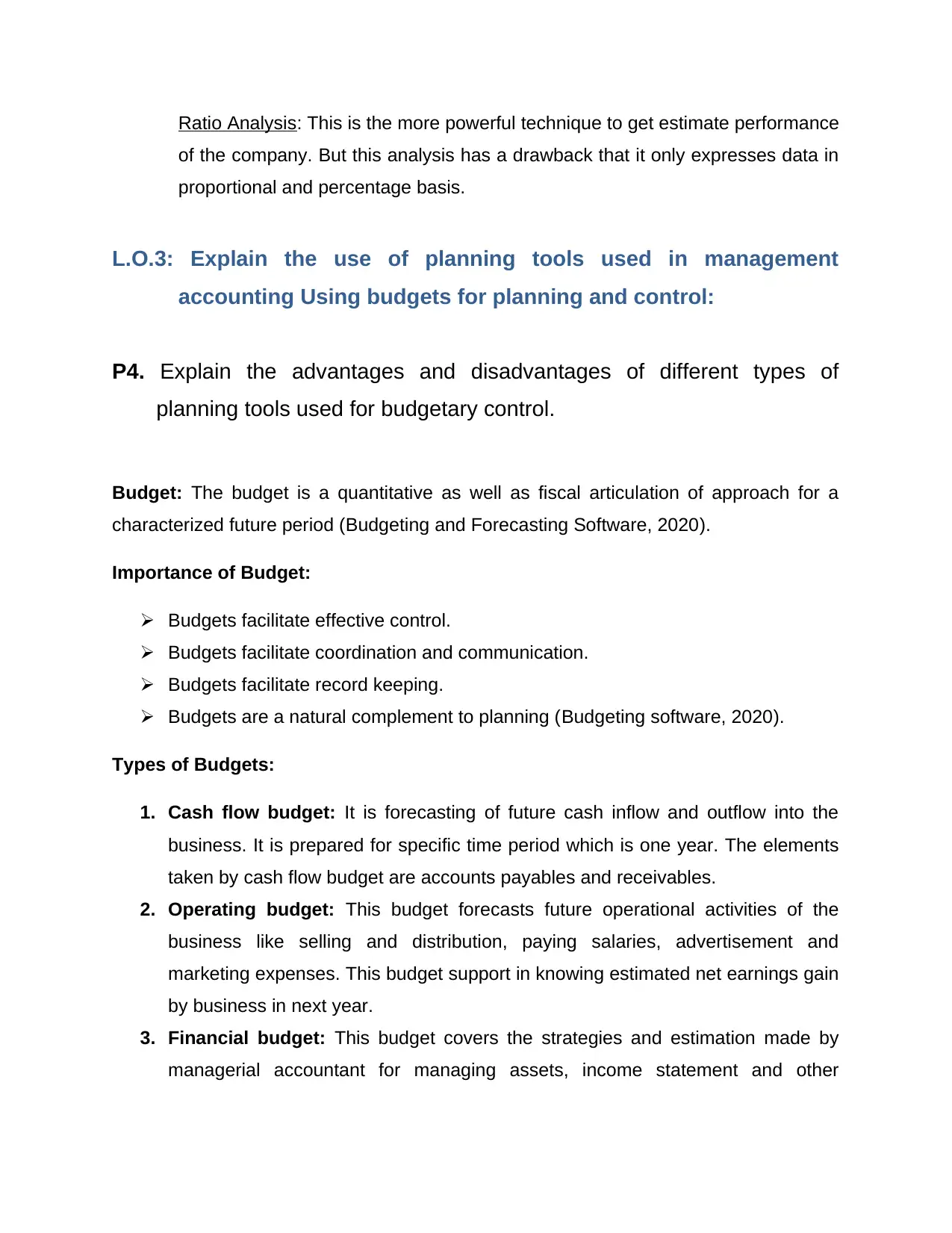
Ratio Analysis: This is the more powerful technique to get estimate performance
of the company. But this analysis has a drawback that it only expresses data in
proportional and percentage basis.
L.O.3: Explain the use of planning tools used in management
accounting Using budgets for planning and control:
P4. Explain the advantages and disadvantages of different types of
planning tools used for budgetary control.
Budget: The budget is a quantitative as well as fiscal articulation of approach for a
characterized future period (Budgeting and Forecasting Software, 2020).
Importance of Budget:
Budgets facilitate effective control.
Budgets facilitate coordination and communication.
Budgets facilitate record keeping.
Budgets are a natural complement to planning (Budgeting software, 2020).
Types of Budgets:
1. Cash flow budget: It is forecasting of future cash inflow and outflow into the
business. It is prepared for specific time period which is one year. The elements
taken by cash flow budget are accounts payables and receivables.
2. Operating budget: This budget forecasts future operational activities of the
business like selling and distribution, paying salaries, advertisement and
marketing expenses. This budget support in knowing estimated net earnings gain
by business in next year.
3. Financial budget: This budget covers the strategies and estimation made by
managerial accountant for managing assets, income statement and other
of the company. But this analysis has a drawback that it only expresses data in
proportional and percentage basis.
L.O.3: Explain the use of planning tools used in management
accounting Using budgets for planning and control:
P4. Explain the advantages and disadvantages of different types of
planning tools used for budgetary control.
Budget: The budget is a quantitative as well as fiscal articulation of approach for a
characterized future period (Budgeting and Forecasting Software, 2020).
Importance of Budget:
Budgets facilitate effective control.
Budgets facilitate coordination and communication.
Budgets facilitate record keeping.
Budgets are a natural complement to planning (Budgeting software, 2020).
Types of Budgets:
1. Cash flow budget: It is forecasting of future cash inflow and outflow into the
business. It is prepared for specific time period which is one year. The elements
taken by cash flow budget are accounts payables and receivables.
2. Operating budget: This budget forecasts future operational activities of the
business like selling and distribution, paying salaries, advertisement and
marketing expenses. This budget support in knowing estimated net earnings gain
by business in next year.
3. Financial budget: This budget covers the strategies and estimation made by
managerial accountant for managing assets, income statement and other
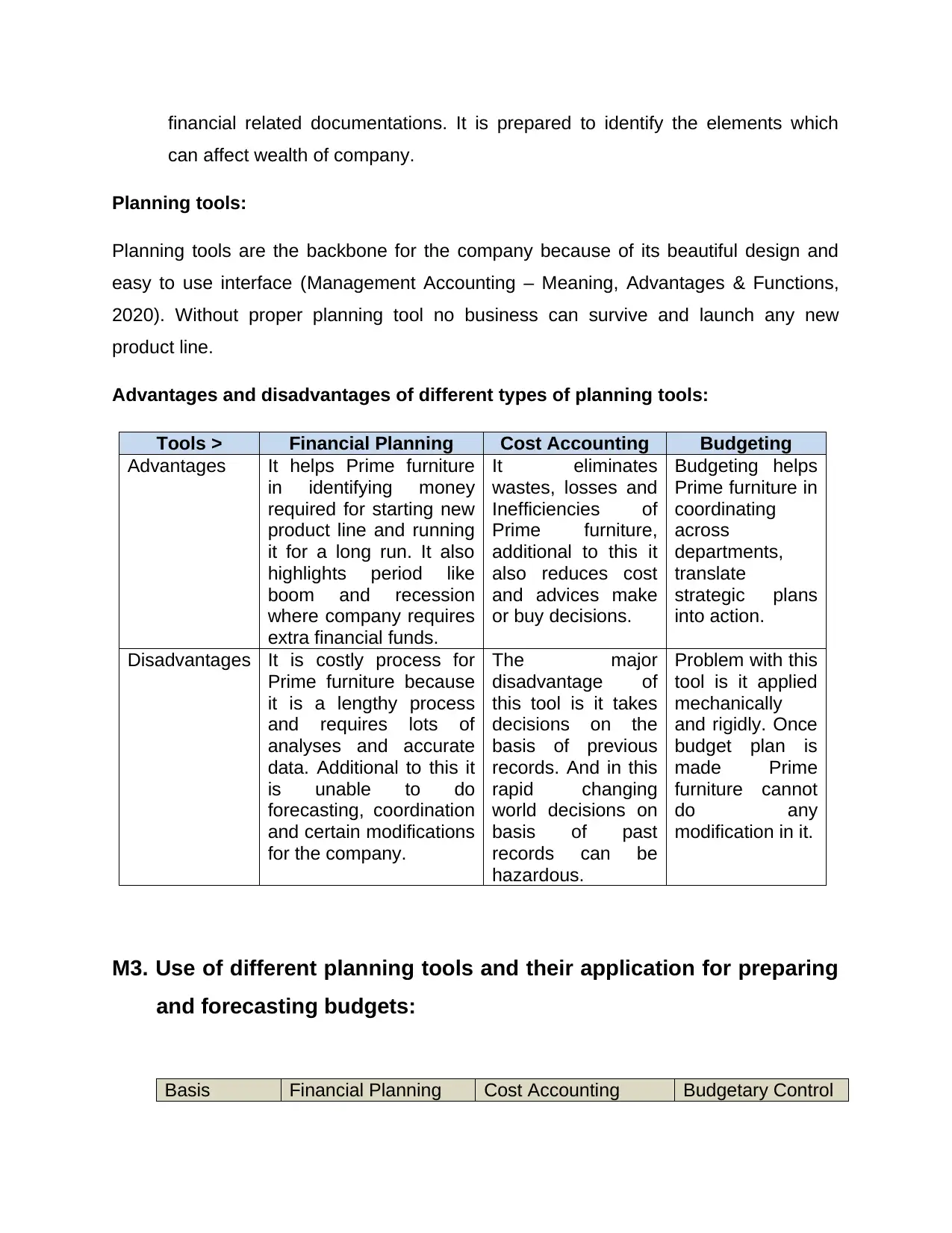
financial related documentations. It is prepared to identify the elements which
can affect wealth of company.
Planning tools:
Planning tools are the backbone for the company because of its beautiful design and
easy to use interface (Management Accounting – Meaning, Advantages & Functions,
2020). Without proper planning tool no business can survive and launch any new
product line.
Advantages and disadvantages of different types of planning tools:
Tools ˃ Financial Planning Cost Accounting Budgeting
Advantages It helps Prime furniture
in identifying money
required for starting new
product line and running
it for a long run. It also
highlights period like
boom and recession
where company requires
extra financial funds.
It eliminates
wastes, losses and
Inefficiencies of
Prime furniture,
additional to this it
also reduces cost
and advices make
or buy decisions.
Budgeting helps
Prime furniture in
coordinating
across
departments,
translate
strategic plans
into action.
Disadvantages It is costly process for
Prime furniture because
it is a lengthy process
and requires lots of
analyses and accurate
data. Additional to this it
is unable to do
forecasting, coordination
and certain modifications
for the company.
The major
disadvantage of
this tool is it takes
decisions on the
basis of previous
records. And in this
rapid changing
world decisions on
basis of past
records can be
hazardous.
Problem with this
tool is it applied
mechanically
and rigidly. Once
budget plan is
made Prime
furniture cannot
do any
modification in it.
M3. Use of different planning tools and their application for preparing
and forecasting budgets:
Basis Financial Planning Cost Accounting Budgetary Control
can affect wealth of company.
Planning tools:
Planning tools are the backbone for the company because of its beautiful design and
easy to use interface (Management Accounting – Meaning, Advantages & Functions,
2020). Without proper planning tool no business can survive and launch any new
product line.
Advantages and disadvantages of different types of planning tools:
Tools ˃ Financial Planning Cost Accounting Budgeting
Advantages It helps Prime furniture
in identifying money
required for starting new
product line and running
it for a long run. It also
highlights period like
boom and recession
where company requires
extra financial funds.
It eliminates
wastes, losses and
Inefficiencies of
Prime furniture,
additional to this it
also reduces cost
and advices make
or buy decisions.
Budgeting helps
Prime furniture in
coordinating
across
departments,
translate
strategic plans
into action.
Disadvantages It is costly process for
Prime furniture because
it is a lengthy process
and requires lots of
analyses and accurate
data. Additional to this it
is unable to do
forecasting, coordination
and certain modifications
for the company.
The major
disadvantage of
this tool is it takes
decisions on the
basis of previous
records. And in this
rapid changing
world decisions on
basis of past
records can be
hazardous.
Problem with this
tool is it applied
mechanically
and rigidly. Once
budget plan is
made Prime
furniture cannot
do any
modification in it.
M3. Use of different planning tools and their application for preparing
and forecasting budgets:
Basis Financial Planning Cost Accounting Budgetary Control
⊘ This is a preview!⊘
Do you want full access?
Subscribe today to unlock all pages.

Trusted by 1+ million students worldwide
1 out of 20
Related Documents
Your All-in-One AI-Powered Toolkit for Academic Success.
+13062052269
info@desklib.com
Available 24*7 on WhatsApp / Email
![[object Object]](/_next/static/media/star-bottom.7253800d.svg)
Unlock your academic potential
Copyright © 2020–2025 A2Z Services. All Rights Reserved. Developed and managed by ZUCOL.





